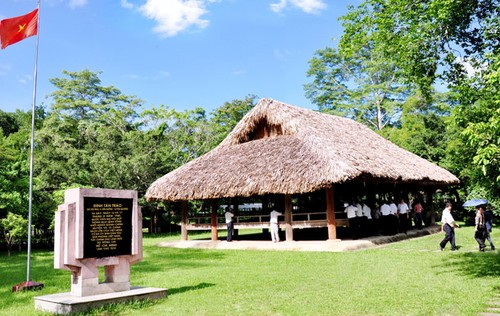(VOVworld) – Prior to the national uprising to seize the reins of the government, a People’s Congress was held in the Tan Trao communal house in Tuyen Quang province on August 16, 1945, involving representatives of sectors, social strata, ethnic groups, political parties, national salvation organizations, and overseas Vietnamese. The Congress illustrated the unity and consensus of Vietnamese people to launch the uprising, eliminate colonialism and feudalism, and lay the foundation for a new regime.
 |
The Tan Trao communal house in Tuyen Quang has become a national historical relic
|
The Tan Trao People’s Congress was a giant step in the struggle for national independence and sovereignty for Vietnam. The Congress, involving more than 60 delegates, was a historic legislative event of the National Assembly, the most powerful organization of the Democratic Republic of Vietnam.
Representing all people to decide national faith
General Secretary of the Indochina Communist Party, Truong Chinh, read a report that focused on two things: the general uprising and the election of a national liberation committee to serve as an interim revolutionary government. The Congress agreed on orientations of the Indochina Communist Party and the Vietnam Federation of Independence to lead the public in an uprising, take back the government, organize a national liberation committee, and select a national flag and national anthem, among other important issues. Major agreements included arming the people, confiscating assets of the adversaries to fund a budget and share out among the poor, organizing a general election, and ensuring democracy and human rights.
Following the successful Congress and the general uprising, the Vietnamese people participated in a general election on January 6, 1946 to elect the first National Assembly of the Democratic Republic of Vietnam and adopt a Constitution. Professor of History Le Van Lan says: “The Tan Trao People’s Congress was the precursor of the VN National Assembly. The Congress’s directions were attributed to the success of the August Revolution. Four months after the Congress, President Ho Chi Minh ordered a general election and the first National Assembly was formed.”
Lessons on the power of national unity
The Tan Trao Congress was a success of President Ho Chi Minh, the Party, and the Vietnam Federation of Independence in promoting national unity and will in the revolutionary struggle for national independence, reunification, and construction.
The Congress taught several valuable lessons about national power, appropriate tactics for each revolutionary period, ensuring democracy, and building a law-governed state of the people, by the people, and for the people. National Assembly Chairman Nguyen Sinh Hung said: “Over the past 70 years, since the Tan Trao Congress, the National Assembly has built on past achievements and continued to improve its organization and performance. The National Assembly has promoted its role as the highest representative of the people and the most powerful organ of the state, contributing to national independence, reunification, and development.”
The organization of the Tan Trao Congress 70 years ago was a turning point in Vietnam’s history. The Vietnam National Assembly will continue to creatively apply its lessons in the new period.